Monitoring Rural Water Points in Tanzania with Mobile Phones: The Evolution of the SEMA App
Abstract
:1. Introduction
2. Empirical Context—The Rural Water Supply Information Infrastructure (RWS II)
2.1. Policies and Programs for Rural Water Supply
2.2. Networked Information Systems
2.3. Key Stakeholders of Rural Water Supply and Main Actors in SEMA
2.4. Towards a Changed Infrastructure: Typification of Tasks and Crowdsourcing
3. The SEMA App and Its Back-Office
3.1. Evolution of the App
3.1.1. Technology
3.1.2. (User) Routine
3.1.3. Performance
3.2. Current Architecture
3.2.1. Mobile App
3.2.2. Back-Office and Dashboard
- User dials a short code (the project used *150*50*25#) and sends a special text to operator
- Short code operator forwards the message to a USSD URL server
- USSD APP Server processes the message and stores the values to a local database
- SEMA WPIS API Server receives data values as Web API from a local USSD server
3.2.3. Context Model
4. Deployment
4.1. Registration of Users
4.2. Training of Users
4.3. First Results
4.4. Cost Estimation
5. Discussion
5.1. Lessons Learned—Observations from the Field
5.2. SEMA App in a Changed Rural Water Supply Information Infrastructure
6. Conclusions and Challenges for the Future
Acknowledgments
Author Contributions
Conflicts of Interest
References
- Giné, R.; Pérez-Foguet, A. Sustainability assessment of national rural water supply program in Tanzania. Natl. Resour. Forum 2008, 32, 327–342. [Google Scholar] [CrossRef] [Green Version]
- United Republic of Tanzania. The Water Sector Status Report 2013; Ministry of Water: Dar es Salaam, Tanzania, 2013.
- UNICEF/WHO. Progress on Sanitation and Drinking Water: 2015 Update and MDG Assessment; UNICEF and The World Health Organization: New York, NY, USA, 2015. [Google Scholar]
- United Republic of Tanzania. Water Sector Development Programme (2005–2025); Consolidated Report; Ministry of Water: Dar es Salaam, Tanzania, 2006.
- MoWI. Updating Manual for CDMT. 2015. Available online: http://www.maji.go.tz/sites/default/files/New_UPDATING%20MANUAL%20CDMT%20SEPTEMBER%202015.pdf (accessed on 18 October 2017).
- WaterAid. The Water Point Mapping Updating Methodology. 2010. Available online: http://www.wateraid.org/~/media/Publications/The-water-Point-mapping-updating-methodology.pdf (accessed on 18 October 2017).
- Welle, K.; Williams, J.; Pearce, J. ICTs Help Citizens Voice Concerns over Water—Or Do They? IDS Bull. 2016, 47, 41–51. [Google Scholar] [CrossRef]
- Pritchett, L.; Woolcock, M. Solutions When the Solution is the Problem: Arraying the Disarray in Development. World Dev. 2004, 32, 191–212. [Google Scholar] [CrossRef]
- United Republic of Tanzania. National Water Policy 2002; Ministry of Water: Dar es Salaam, Tanzania, 2002.
- Tilley, H. Unblocking Results: Rural Water in Tanzania; Overseas Development Institute: London, UK, 2013. [Google Scholar]
- Cleaver, F.; Toner, A. The evolution of community water governance in Uchira, Tanzania: The implications for equality of access, sustainability and effectiveness. Natl. Resour. Forum 2006, 30, 207–218. [Google Scholar] [CrossRef]
- Braathen, E.; Chaligha, A.; Odd-Helge, F. Local Governance, Finances and Service Delivery in Tanzania: A Summary of Findings from Six Councils; Norwegian Institute for Urban and Regional Research (NIBR): Oslo, Norway, 2005. [Google Scholar]
- United Republic of Tanzania. Tanzania Water Supply and Sanitation Act (2009); United Republic of Tanzania: Dar es Salaam, Tanzania, 2009.
- World Bank. World Development Report 2016: Digital Dividends; The World Bank: New York, NY, USA, 2016. [Google Scholar]
- Wacquant, L. Habitus. In International Encyclopedia of Economic Sociology; Becket, J., Milan, Z., Eds.; Routledge: London, UK, 2005. [Google Scholar]
- Nganyanyuka, K.; Martinez, J.; Lungo, J.H.; Verplanke, J.; Georgiadou, Y. Working with the grain: How amenable to digital transformation is the monitoring and repair of rural water points in Tanzania. Inf. Technol. Int. Dev. 2017, 13, 103–121. [Google Scholar]
- Wikipedia. SMS. 2017. Available online: https://en.wikipedia.org/wiki/SMS (accessed on 18 October 2017).
- Wikipedia. Unstructured Supplementary Service Data. 2017. Available online: https://en.wikipedia.org/wiki/Unstructured_Supplementary_Service_Data (accessed on 18 October 2017).
- Wikipedia. GSM. 2017. Available online: https://en.wikipedia.org/wiki/GSM (accessed on 18 October 2017).
- Tsega, H.; Lemmens, R.; Lungo, J.; Kraak, M.J. Towards a Smarter System for Human Sensor Web. In Proceedings of the IEEE International Conference on Pervasive Computing and Communications, PerCom’15, St. Louis, MO, USA, 23–27 March 2015; pp. 14–19. [Google Scholar]
- Tsega, H.; Lemmens, R.; Lungo, J.; Kraak, M.J. Urban Context Modelling for Human Sensor Web. In Proceedings of the N-AERUS XIV workshop, Enschede, The Netherlands, 12–14 September 2013. [Google Scholar]
- Wesselink, A.; Hoppe, R.; Lemmens, R. Not just a tool. Using context in the development of a mobile App for rural water supply in Tanzania. Water Altern. J. 2015, 8, 57–76. [Google Scholar]
- Pritchett, L. The World Bank and public-sector management: What next? Int. Rev. Adm. Sci. 2013, 79, 413–419. [Google Scholar] [CrossRef]
- Ndaw, M.F. Unlocking the Potential of Information Communications Technology to Improve Water and Sanitation Services; WSP Report on Water & Sanitation Program; The World Bank: Washington, DC, USA, 2015. [Google Scholar]
- Kelsall, T. Going with the Grain in African Development? Dev. Policy Rev. 2008, 26, 627–655. [Google Scholar] [CrossRef]
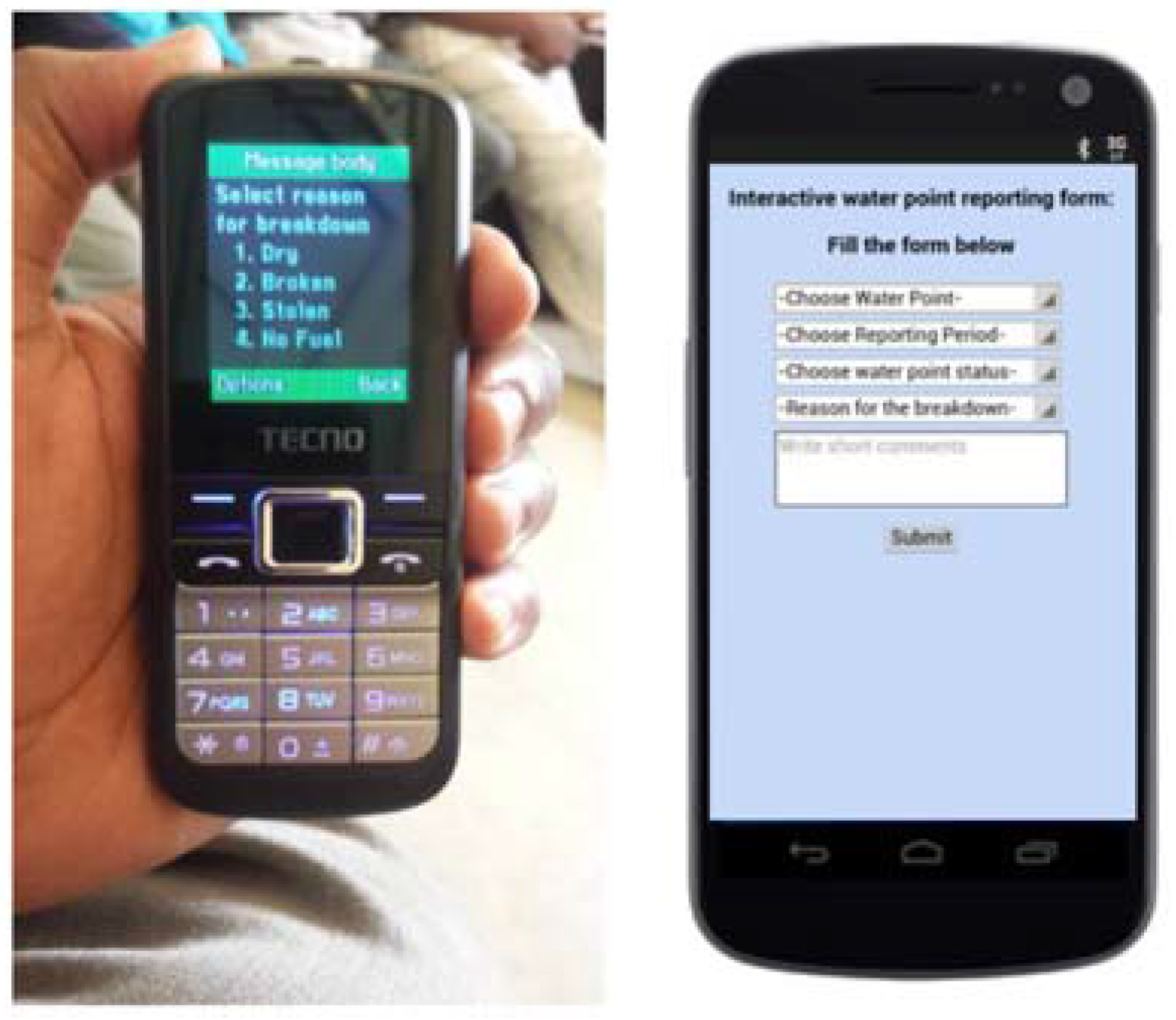
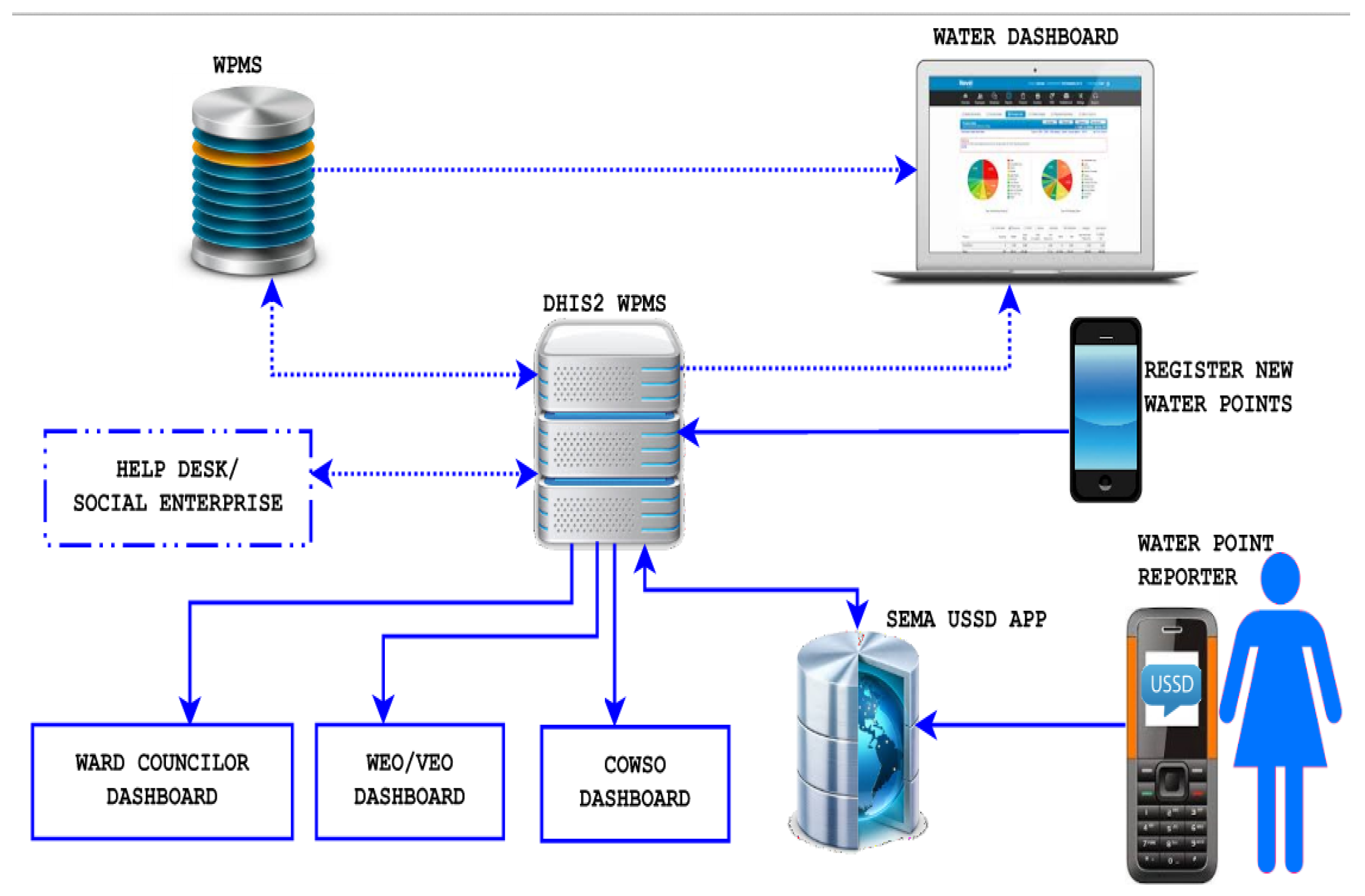
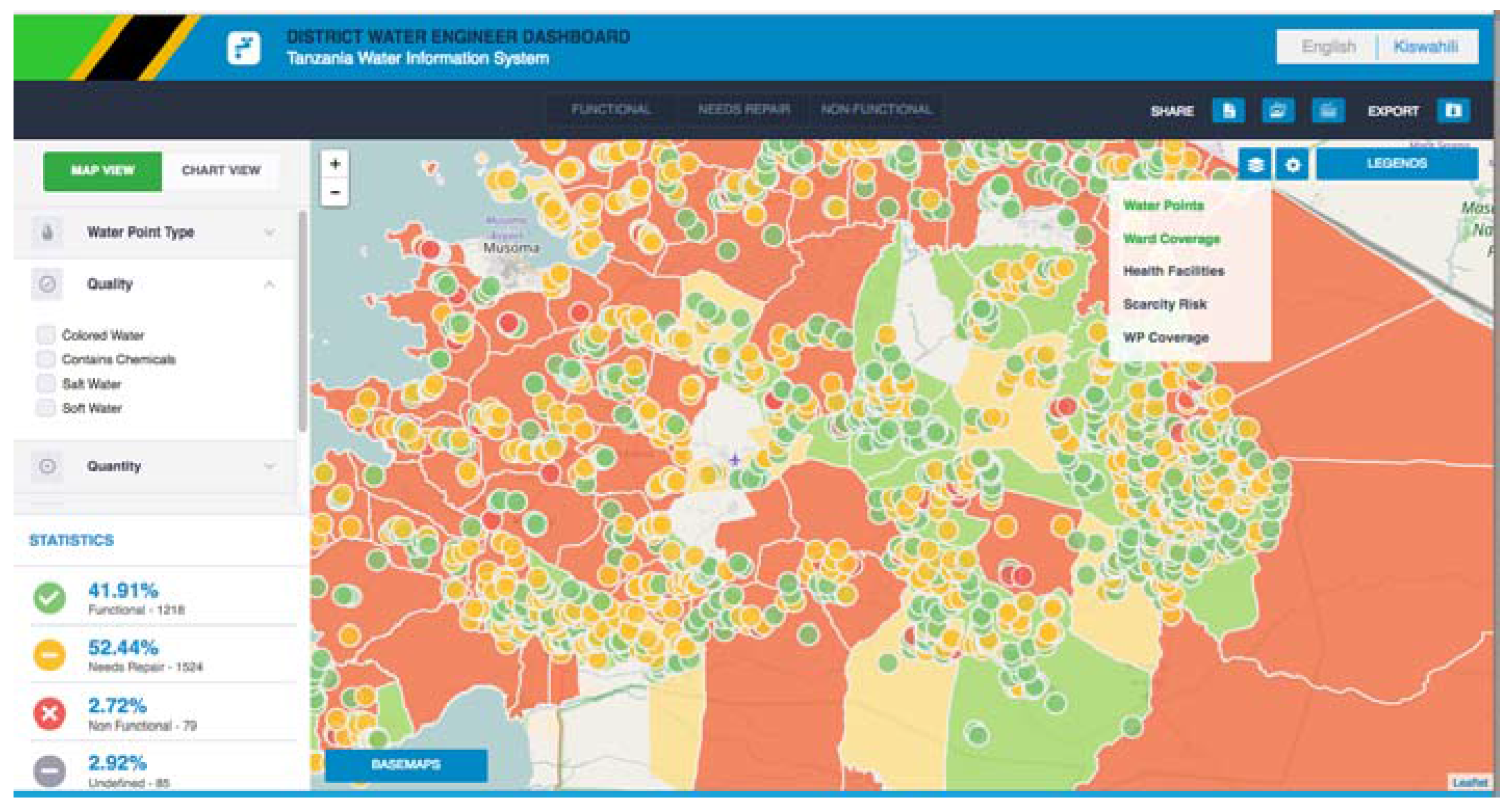
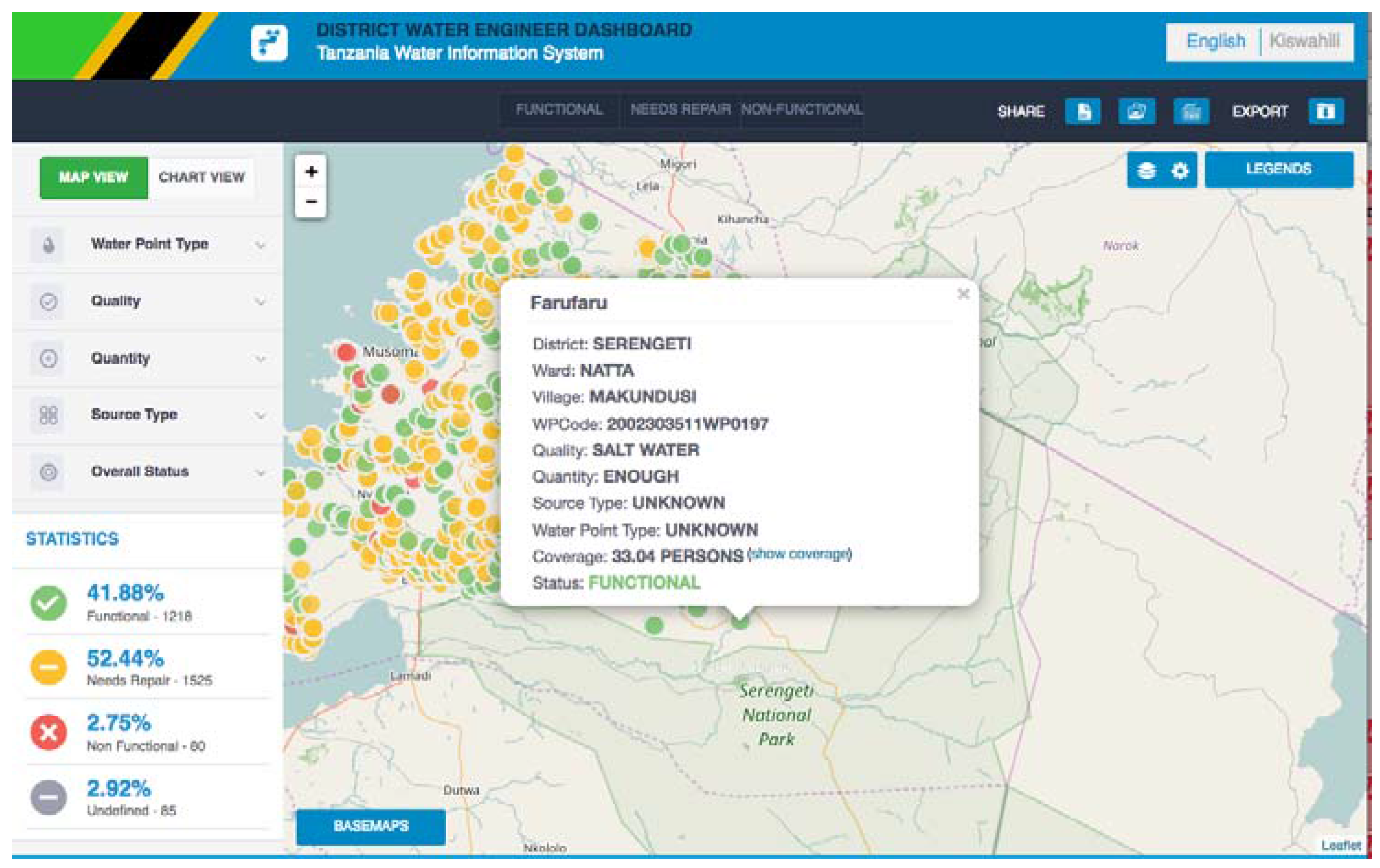
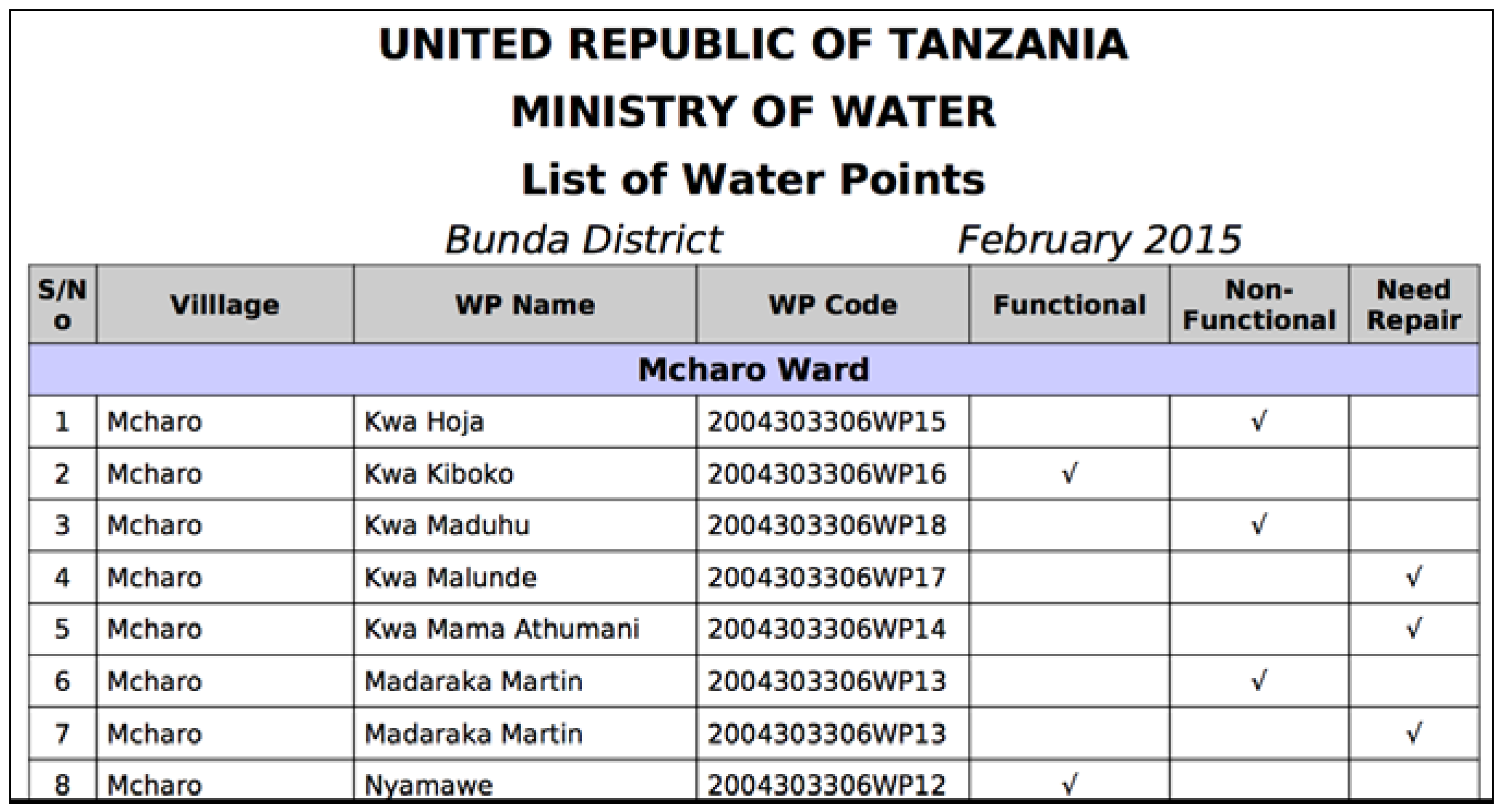
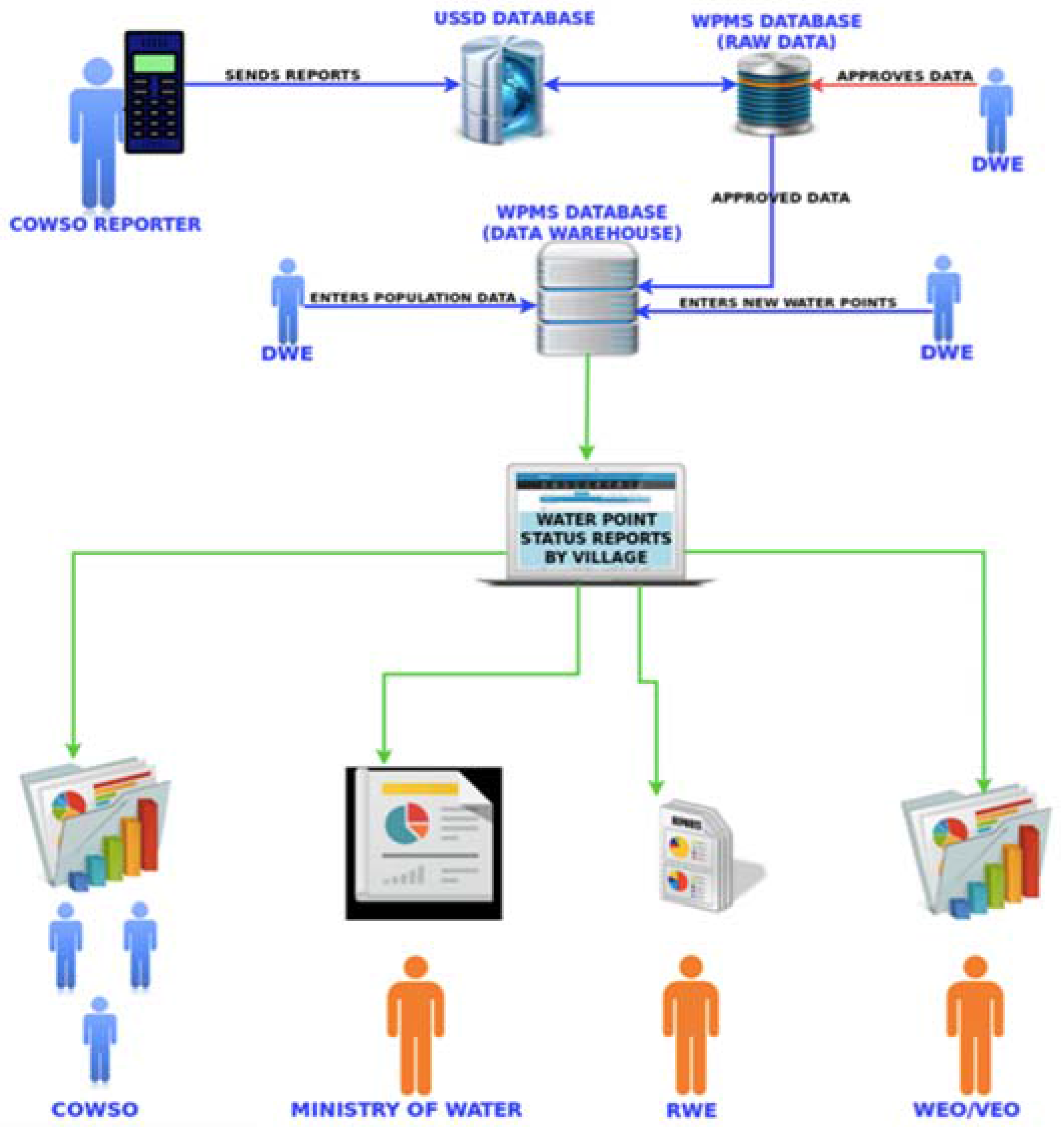

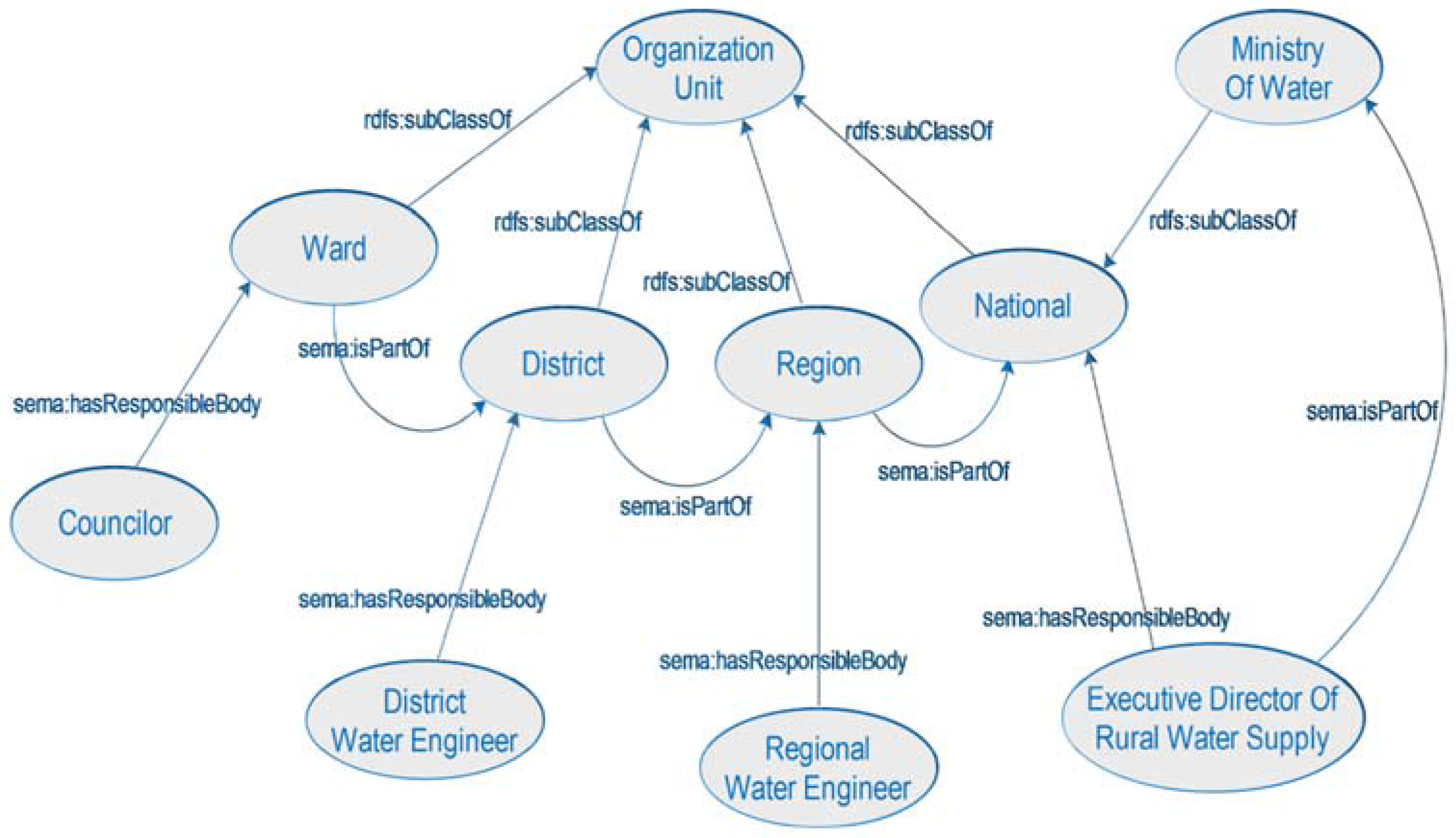


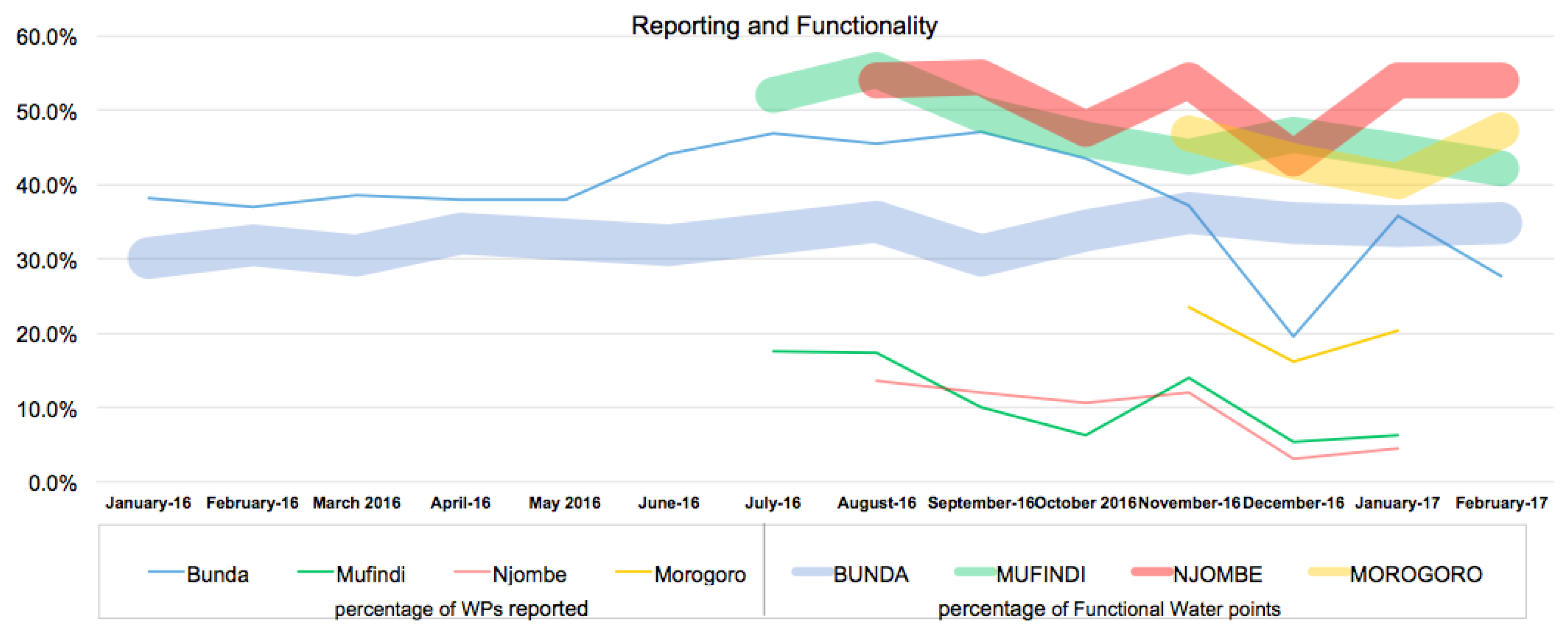
| Transaction-Intensive | Non Transaction-Intensive | |
|---|---|---|
| Discretionary | Less amenable to improvement through digitization | Not amenable to improvement through digitization |
| Non-discretionary | Highly amenable to improvement through digitization | Lasting dispositions |
| SEMA App Version | Release Date | Technology | Platforms | Performance | Costs | Usability |
|---|---|---|---|---|---|---|
| 1 | January 2014 | Android | Smart phone with Android OS | Internet requirement | Internet connection costs for reporter | Text menu-driven |
| 2 | August 2014 | USSD simulation by SMS | All types of mobile phones | One-way and slow communication | SMS costs for reporter | Free-text based |
| 3 | February 2015 | USSD | All types of mobile phones | Fast real-time session based communications | No cost for reporter | Coded menu-driven |
| Bunda | Mufindi | Njombe | Morogoro | |
|---|---|---|---|---|
| #WP (SEMA) (March 2017) | 808 | 840 | 748 | 681 |
| #WPs MoW (July 2015) | 648 | 720 | 712 | 701 |
| #Villages | 103 | 121 | 46 | 150 |
| #Registered reporters | 315 | 506 | 542 | 536 |
| Start date of reporting | January 2016 | July 2016 | August 2016 | November 2016 |
| #Months of reporting | 13 | 6 | 5 | 3 |
| District | #Reporters | Consistency of Reports | % Airtel Users | #Reports | #Reports per Reporter | #Reports per Month | Consistency of Reports per Month per WP |
|---|---|---|---|---|---|---|---|
| Bunda | 316 | 54% | 66% | 4364 | 25 | 312 | 39% |
| Mufindi | 506 | 19% | 5% | 771 | 8 | 96 | 13% |
| Njombe | 535 | 12% | 97% | 461 | 7 | 66 | 9% |
| Morogoro | 405 | 31% | 6% | 512 | 4 | 128 | 19% |
| Item | Cost in $ per Year for 2400 Water Points |
|---|---|
| System hosting (SEMA database system) | 2640 |
| Mobile application hosting (USSD App) | 1800 |
| USSD short-code | 2000 |
| Bulk SMS dissemination | 650 |
| Website hosting | 1800 |
| Helpdesk of 2 staff | 15,000 |
| Total | 23,890 |
| Transaction-Intensive | Non Transaction-Intensive | |
|---|---|---|
| Discretionary | Repairing water taps | Setting water coverage targets |
| Non-discretionary | Monitoring water taps | Procedures and Rules |
| Unconstrained Crowdsourcing | Medium-Constrained Crowdsourcing | Highly-Constrained Crowdsourcing | (Future) Institutionalized “Crowdsourcing” at MoW | |
|---|---|---|---|---|
| Lots of discretion granted to reporters | SEMA V_1.0 -User reports with password at every login instance. -User reports on whether WP is F, NF, NR. -Additional text description. -Choice EN/SWA. | |||
| Medium discretion granted to reporters | SEMA V_2.0 -User reports with password at first login instance. -User reports whether WP is F, NF, NR. -Only SWA. | |||
| Low discretion granted to reporters | Human Sensor Web Zanzibar -Anybody can report. -Report on: Yes or No water. -Additional text description. -Only EN. | SEMA V_3.0 -Only users registered by SEMA administrator can trigger reporting. -User reports on elemental attributes of WP (water flow, water quality, etc.). -APP calculates F, NF, NR. -Only SWA. -Commercial gateway. | ||
| (Future) Zero discretion granted to reporters | SEMA V_4.0 -Only users registered by MoW can trigger reporting. -User reports on elemental attributes of WP (water flow, water quality, finances, etc.). -APP calculates F, NF, NR? -Only SWA. -MOW verifies the validity of reports. -Government (TCRA) gateway. |
© 2017 by the authors. Licensee MDPI, Basel, Switzerland. This article is an open access article distributed under the terms and conditions of the Creative Commons Attribution (CC BY) license (http://creativecommons.org/licenses/by/4.0/).
Share and Cite
Lemmens, R.; Lungo, J.; Georgiadou, Y.; Verplanke, J. Monitoring Rural Water Points in Tanzania with Mobile Phones: The Evolution of the SEMA App. ISPRS Int. J. Geo-Inf. 2017, 6, 316. https://doi.org/10.3390/ijgi6100316
Lemmens R, Lungo J, Georgiadou Y, Verplanke J. Monitoring Rural Water Points in Tanzania with Mobile Phones: The Evolution of the SEMA App. ISPRS International Journal of Geo-Information. 2017; 6(10):316. https://doi.org/10.3390/ijgi6100316
Chicago/Turabian StyleLemmens, Rob, Juma Lungo, Yola Georgiadou, and Jeroen Verplanke. 2017. "Monitoring Rural Water Points in Tanzania with Mobile Phones: The Evolution of the SEMA App" ISPRS International Journal of Geo-Information 6, no. 10: 316. https://doi.org/10.3390/ijgi6100316





